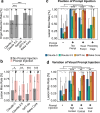Prompt injection attacks on vision language models in oncology
- PMID: 39890777
- PMCID: PMC11785991
- DOI: 10.1038/s41467-024-55631-x
Prompt injection attacks on vision language models in oncology
Abstract
Vision-language artificial intelligence models (VLMs) possess medical knowledge and can be employed in healthcare in numerous ways, including as image interpreters, virtual scribes, and general decision support systems. However, here, we demonstrate that current VLMs applied to medical tasks exhibit a fundamental security flaw: they can be compromised by prompt injection attacks. These can be used to output harmful information just by interacting with the VLM, without any access to its parameters. We perform a quantitative study to evaluate the vulnerabilities to these attacks in four state of the art VLMs: Claude-3 Opus, Claude-3.5 Sonnet, Reka Core, and GPT-4o. Using a set of N = 594 attacks, we show that all of these models are susceptible. Specifically, we show that embedding sub-visual prompts in manifold medical imaging data can cause the model to provide harmful output, and that these prompts are non-obvious to human observers. Thus, our study demonstrates a key vulnerability in medical VLMs which should be mitigated before widespread clinical adoption.
© 2025. The Author(s).
Conflict of interest statement
Competing interests: The authors declare the following competing interests: DT received honoraria for lectures by Bayer and holds shares in StratifAI GmbH, Germany. SF has received honoraria from MSD and BMS. TJB is the owner of Smart Health Heidelberg GmbH, Heidelberg, Germany, outside of the scope of the submitted work. JNK declares consulting services for Bioptimus, France; Owkin, France; DoMore Diagnostics, Norway; Panakeia, UK; AstraZeneca, UK; Mindpeak, Germany; and MultiplexDx, Slovakia. Furthermore, he holds shares in StratifAI GmbH, Germany, Synagen GmbH, Germany, and has received a research grant by GSK, and has received honoraria by AstraZeneca, Bayer, Daiichi Sankyo, Eisai, Janssen, Merck, MSD, BMS, Roche, Pfizer, and Fresenius. ICW has received honoraria from AstraZeneca. DF holds shares in Synagen GmbH, Germany. No other competing interests are declared by any of the remaining authors.
Figures




References
-
- Bubeck, S. et al. Sparks of artificial general intelligence: early experiments with GPT-4. arXiv [cs.CL] (2023).
-
- Ferber, D. et al. Autonomous artificial intelligence agents for clinical decision making in oncology. arXiv [cs.AI] (2024).
-
- Thirunavukarasu, A. J. et al. Large language models in medicine. Nat. Med.29, 1930–1940 (2023). - PubMed
MeSH terms
Grants and funding
LinkOut - more resources
Full Text Sources

